Best management guide
Faba bean production: southern and western region
Australian industry
The Australian faba bean industry began in the 1980s and has grown steadily to become the world’s #1 exporter. Faba bean are now grown in all Australian grain production regions.
The large-seeded broad bean is well adapted to higher rainfall areas because of its higher yield potential, better disease and waterlogging tolerance and higher prices.
Bean types differ in shape and colour with sizes ranging the small seeded ‘Fiord type’ faba bean to medium size ‘Fiesta types’ to the larger PBA Rana. There is also the large seeded broad bean (Aquadulce and PBA Kareema) and the round horse or tic bean with small to medium sized seed.
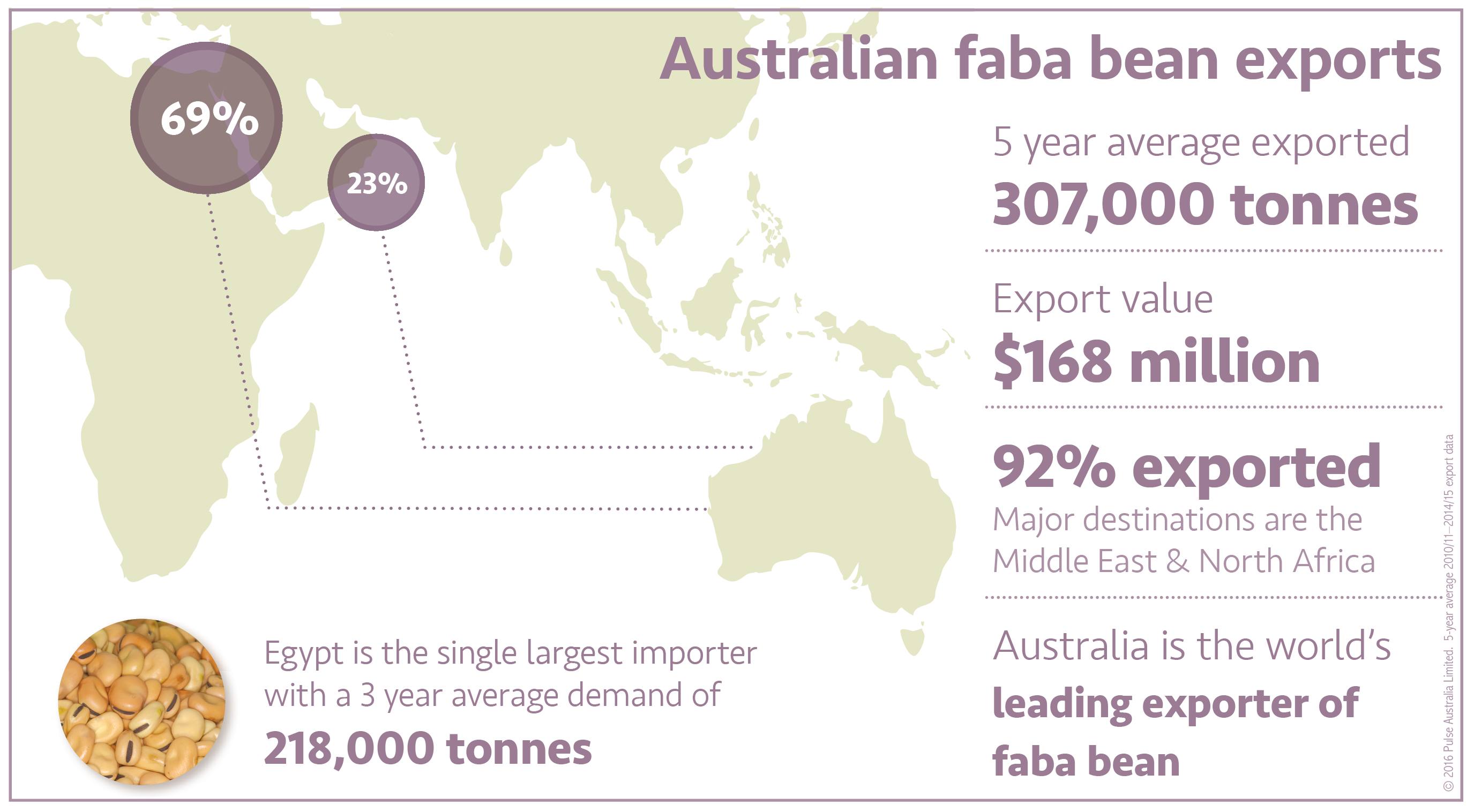
Types
Faba bean
Faba bean (Vicia faba minor) originated in the Middle East and are now an important food crop in China and many Mediterranean and African countries. As faba beans receive greater attention in the western word, because of the value in livestock nutrition and crop rotation, there will be an increasing export potential for Australian grain.
Broad bean
Broad bean (Vicia faba major) is the same species as faba bean and markets are also similar (i.e. mainly Middle East) but they have a wider Australian use, for example they are exported to Southern Europe and also South East Asia where they are roasted for use as snack food.
The broad bean plant is virtually identical to the faba bean but has a slightly longer growing season and is therefore suited to regions of slightly higher rainfall (>500 mm) to achieve the seed size. Prime growing areas are the south-west of Victoria and south-east of South Australia. Like faba bean, broad bean tolerates waterlogging and the plants turn black at maturity.
Place in the rotation
Faba bean is a versatile and lucrative pulse crop in Australia that offers a number of rotational and financial benefits in many cropping systems.
| Advantages | Disadvantages |
|
|
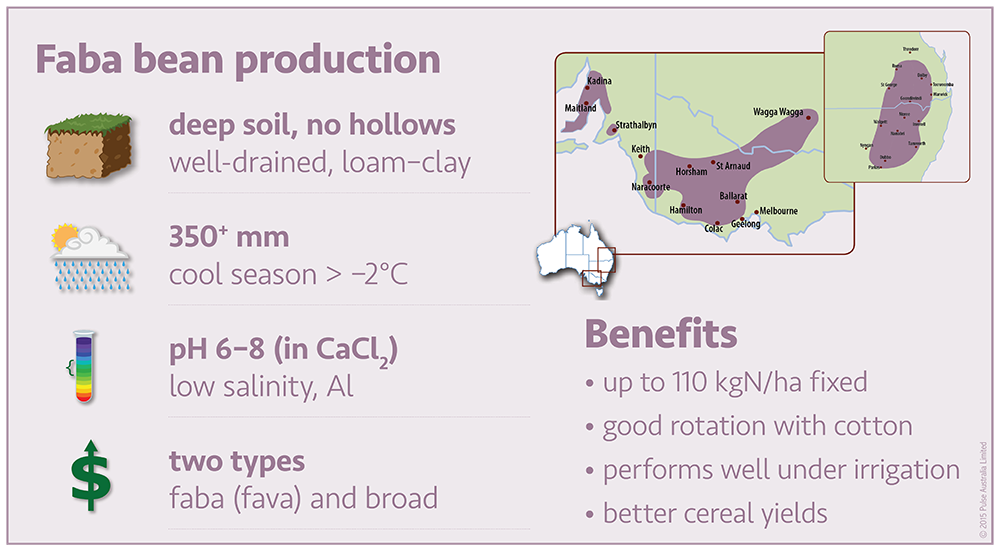
Faba bean, and especially broad bean, are not well suited to lower rainfall areas. If moisture is limiting, the plants do not grow to full height and the pods set close to the ground. They do not tolerate hot conditions during flowering, which can result in poor pod set and premature termination of flowering. Hot and dry conditions during flowering usually results in severe reduction in yield potential. Stubble retention and planting in wider rows can enable faba bean to be grown in lower rainfall areas and seasons.
Faba bean and broad bean prefer well-drained loam to clay soils with a pH in the range of 6–9. They will not grow as well in light or acidic soils. They are known for being the pulse that is most tolerant of waterlogging, however to survive prolonged waterlogged conditions the plants must be well nodulated and foliar diseases must be controlled. Waterlogging will still impact on crop growth so although the plants will grow and set seed the plants are likely to be stunted and will yield less than plants growing in well-drained soil.
Faba and broad bean are moderately susceptible to hostile sub-soils, however boron toxicity, sodicity and salinity can cause patchiness in affected paddocks. Faba bean and broad bean do not tolerate exchangeable aluminium in soil.
Keys to successful production
- Make faba beans part of an integrated cropping system involving wheat, canola or barley, or summer crops such as cotton, sorghum or maize. Take a systems perspective and assess financial performance over several seasons to determine the true benefits of faba beans in a rotation.
- Choose the right variety based on long term yield data for the region, maturity, disease resistance and market opportunities for either human consumption or stockfeed.
- Use good quality seed. Obtain certified seed, or keep good quality home-grown seed, with high germination (80%+) and vigour. Seed must be free from seed-borne ascochyta pathogens.
- Select and manage paddocks well in advance to control weeds and retain crop residues. Select paddocks with free draining soil of more neutral pH and low sodicity, salinity and boron toxicity. Take previous residual herbicide use into account and factor in the effect of the likely weed burden and the available control options.
- Establish optimum plant populations for the variety, situation and sowing time. Ideally ground cover should coincide with the beginning of pod filling. Plant populations can range from as few as 20 plants/m2 (even less with broad beans) up to 35 plants/m2 for rain-fed crops or even higher if sown late.
- Sow on time. Sowing time is critical so follow the regional recommendations. Late sowing lowers crop biomass, shortens the pod-filling period and increases the risks associated with moisture stress and high temperatures, all of which reduces yield potential.
- Ensure good crop nutrition. Well nodulated faba bean and broad bean plants do not require any nitrogen (N) fertiliser. Inoculate the seed at sowing with commercially available rhizobia inoculant to ensure effective nodulation. On phosphorus (P) deficient country, apply fertiliser at rates similar to or slightly above those required for wheat. On alkaline clay soils, application of zinc fertiliser may be warranted. Acid soils may be deficient in molybdenum, which should be applied at or before sowing if required.
- Know the disease threats to faba beans and how to manage them for your district. The major risks to faba bean are ascochyta blight, chocolate spot and plant viruses, and occasionally rust. No varieties are resistant to all fungal and virus diseases. The impact of fungal diseases on yield can be reduced through the strategic selection and use of fungicides and following best practice crop management including isolating new crops 500 m from the previous year’s faba bean stubble and eradicating volunteer plants over summer and autumn.
- Control insect pests. Use Gaucho® 350SD seed dressing and controlling any ‘green bridge’ over summer to deter aphids from infesting the crop in the early growth stages. Monitor for helicoverpa caterpillars that are likely to infest the crop and damage pods during pod-filling and may make the seed unsuitable for human consumption markets.
- Harvest on time, with a properly set-up header. Start when nearly all pods are black, but before stems become completely dry and black. If the header settings are correct, pods will thresh easily to yield clean, whole seeds with a minimum of splits and cracks.
- Have a marketing plan for on-farm storage or delivery options off-header, which may involve forward contracting if storage, pools or warehousing is not an option.
- Optimise irrigation set ups and timing. Faba beans respond well to irrigation in dry areas. Furrow irrigation is successful in southern irrigation areas with either pre-water and sow, or dry-sow and water-up. To maximise yield potential, crops should be watered to produce maximum biomass, and not allowed to stress during flowering and pod-fill.
Plant physiology
Faba bean plants stand erect and can grow to around 2 m at maturity, however most Australian crops are less than 1.5 m tall. They produce branches stemming from the base. Leaves are compound, with leaves from in the early growth stages having only 2 leaflets and leaves formed after the commencement of flowering have up to 7 leaflets per leaf.
The tap root penetrates to around 60 cm with a profusion of fibrous roots. Beans do however produce less roots and are shallower rooted than cereals.
Flowering in early varieties begins from about the 5–7th node (joint) in early maturing varieties and up to node 15 or higher in later maturing varieties. Flowers are in clusters (inflorescences) comprising 3–8 flowers (varying with variety) in the axil (angle between leaf and stem) at each node. Inflorescences form in succession up the stem as each new node is produced over a 6–10 week period, or about 15 flowering nodes. Like many legumes, excess flowers are produced and fewer than 15% will develop into viable pods.
Faba beans are predominantly self-pollinating, however feral bees and introducing hive bees can increase pollination rates and yields. A pollination service is not necessarily practical in many cases due to failure by bees to collect nectar from the tube like flowers. There is a need to distribute hives evenly within the crop and manage the bees by ensuring they do not make honey.
Flowering will finish when daylight temperatures approach 30°C, after which only a few leaf bearing nodes are produced.
Pods in a well-grown crop are borne from about 20–30 cm above ground level. Each pod contains 2–4 seeds, which will vary in size depending on variety.
Bottom pods will mature first and turn black, as will the bottom leaves. This will continue gradually upwards as the plant senesces.
-
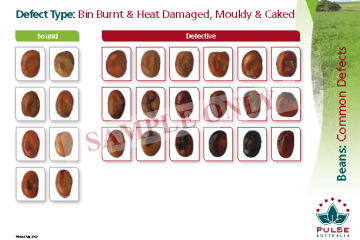
Faba bean: Bin burnt and heat damaged, mould and caked
-
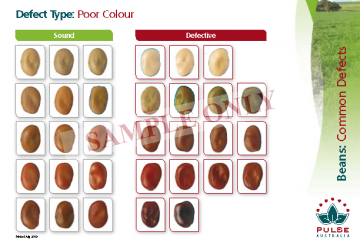
Faba bean: poor colour
-
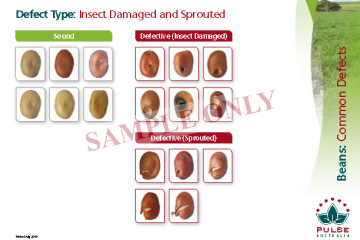
Faba bean: Insect damaged and sprouted
Last updated: 15 January 2016
